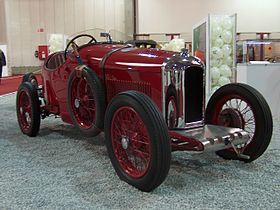
Angela Isadora Duncan was an American-born dancer and choreographer, who was a pioneer of modern contemporary dance and performed to great acclaim throughout Europe and the United States. Born and raised in California, she lived and danced in Western Europe, the U.S., and Soviet Russia from the age of 22. She died when her scarf became entangled in the wheel and axle of the car in which she was travelling in Nice, France.
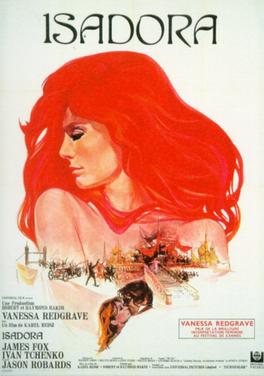
Isadora is a 1968 biographical drama film directed by Karel Reisz from a screenplay written by Melvyn Bragg, Margaret Drabble, and Clive Exton adapted from the books My Life by Isadora Duncan and Isadora, an Intimate Portrait by Sewell Stokes. The film follows the life of American pioneering modern contemporary dance artist and choreographer Isadora Duncan, who performed to great acclaim throughout the US and Europe during the 19th century. A co-production between the United Kingdom and France, it stars Vanessa Redgrave as Duncan and also features James Fox, Jason Robards, and John Fraser in supporting roles.

Panhard was a French motor vehicle manufacturer that began as one of the first makers of automobiles. It was a manufacturer of light tactical and military vehicles. Its final incarnation, now owned by Renault Trucks Defense, was formed by the acquisition of Panhard by Auverland in 2005, and then by Renault in 2012. In 2018 Renault Trucks Defense, ACMAT and Panhard combined under a single brand, Arquus.
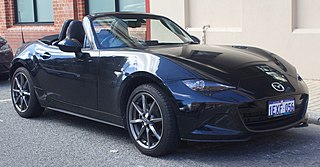
A roadster is an open two-seat car with emphasis on sporting appearance or character. Initially an American term for a two-seat car with no weather protection, its usage has spread internationally and has evolved to include two-seat convertibles.

Book the Fifth: The Austere Academy is the fifth novel in the children's novel series A Series of Unfortunate Events by Lemony Snicket. The Baudelaire orphans are sent to a boarding school, overseen by monstrous employees. There, the orphans meet new friends, new enemies, and Count Olaf in disguises.
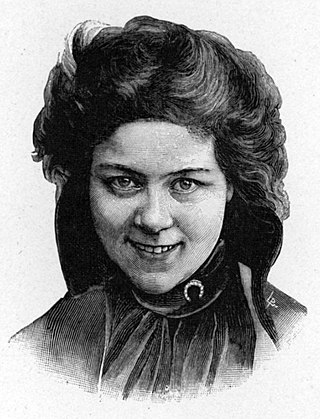
Loie Fuller, also known as Louie Fuller and Loïe Fuller, was an American dancer and a pioneer of modern dance and theatrical lighting techniques.

A steering wheel is a type of steering control in vehicles.

A tutu is a dress worn as a costume in a classical ballet performance, often with attached bodice. It may be made of tarlatan, muslin, silk, tulle, gauze, or nylon. Modern tutus have two basic types: the Romantic tutu is soft and bell-shaped, reaching the calf or ankle; the Classical tutu is short and stiff, projecting horizontally from the waist and hip.
The Amilcar was a French automobile manufactured from 1921 to 1940.

Wire wheels, wire-spoked wheels, tension-spoked wheels, or "suspension" wheels are wheels whose rims connect to their hubs by wire spokes. Although these wires are considerably stiffer than a similar diameter wire rope, they function mechanically the same as tensioned flexible wires, keeping the rim true while supporting applied loads. The term suspension wheel should not be confused with vehicle suspension.

A marron glacé is a confection, originating in France or Italy consisting of a chestnut candied in sugar syrup and glazed. Marrons glacés are an ingredient in many desserts and are also eaten on their own.

Impéria Automobiles was a Belgian manufacturer of automobiles, active between 1906 and 1948. Its factory in Nessonvaux, Liège had a rooftop test track since 1928.

The Amilcar CGS Grand Sport was a popular inter war lightweight sports car, manufactured by the French automobile maker Amilcar between 1923 and 1925. A response to the successful Salmson VAL3 series, the "C Grand Sport" was developed from the Amilcar C. The CGS had a longer, more rigid chassis, and improved brakes in addition to its bigger engine.
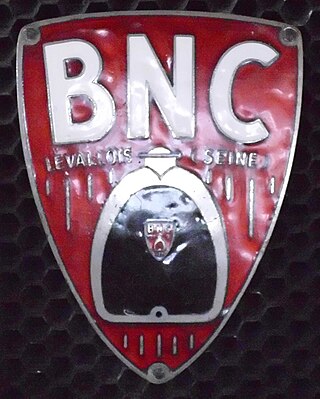
Bollack, Netter, et Cie(French: Bollack Netter et compagnie), more commonly known as B.N.C., was a small French automobile company in Levallois-Perret, situated on Avenue de Paris 39.

Modern dance is a broad genre of western concert or theatrical dance which includes dance styles such as ballet, folk, ethnic, religious, and social dancing; and primarily arose out of Europe and the United States in the late 19th and early 20th centuries. It was considered to have been developed as a rejection of, or rebellion against, classical ballet, and also a way to express social concerns like socioeconomic and cultural factors.
Roman Gregory Chatov (1900–1987) was a Russian-born American artist, painter, designer, and illustrator.

Automobiles Rally was a small company which made sporting automobiles in Colombes, a northwestern suburb of Paris. The company traded from 1921 until 1933, but they did not manage to survive the Great Depression. Known for sporting and handsomely designed cars, Rally competed with other French cyclecar makers of the era such as Amilcar, B.N.C., and Salmson.

Dancer in a Café is an oil painting created in 1912 by the French artist and theorist Jean Metzinger. The work was created while Metzinger and Albert Gleizes, in preparation for the Salon de la Section d'Or, were publishing, Du "Cubisme", the first major defense of the Cubist movement, and it was first displayed at the 1912 Salon d'Automne in Paris. The work proved controversial within the Municipal Council of Paris, causing debate in the Chambre des Députés about the use of public funds to exhibit such 'barbaric' art, with the Cubists being defended by the Socialist deputy Marcel Sembat.
Rétrospectives Automobiles Miniatures was a French manufacturing company that made diecast scale model collector vehicles mostly of classic French automobiles in 1:43 scale. The acronym was seen on packaging without the periods between the letters of the acronym, but on some of the vehicle bases with the punctuation. "J.M.K." was a further acronym that stood for the three founding members of the company: M. Jarry, Henri Malartre and M. Koch. Though the models were often known simply as RAMI, the full name of the company was RAMI by J.M.K.
Five Brahms Waltzes in the Manner of Isadora Duncan is a ballet solo choreographed by Frederick Ashton to music by Johannes Brahms, inspired by Isadora Duncan and created for Lynn Seymour. The first version, under the title Brahms Waltz, used only Brahms' Op. 39, No. 15, and premiered on 22 June 1975, at the Hamburg State Opera. The expanded version, which featured more Brahms waltzes, premiered on 15 June 1976, during Ballet Rambert's 50th anniversary gala, at the Sadler's Wells Theatre, London, and is dedicated to Marie Rambert.
